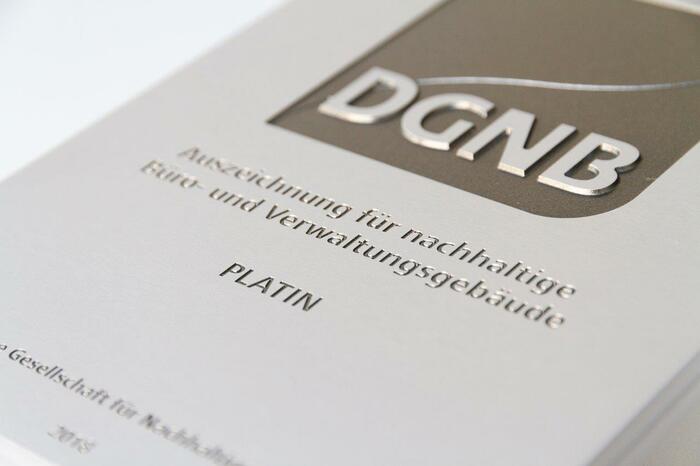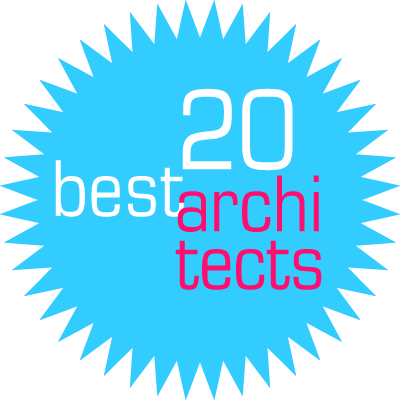Open, simple, sustainable, and people-orientated describes the newly constucted building of Alnatura Working Environment.
Alnatura Working Environment in the city of Darmstadt has reached an architectural milestone in terms of sustainability, material efficiency, openness, and new ways of working in an office building. The building at Alnatura Campus, designed by haascookzemmrich STUDIO2050, offers special features such as the use of an innovative rammed-earth façade and it is the first worldwide instance of using geothermal wall heating. Also remarkable is the sound-absorbing wooden lamella ceiling, which spans the atrium and the entirely open office space.
The building on the site of the former US-Army Kelley Barracks hardly brings to mind a conventional office building and offers space for up to 500 employees on three floors with a floor area of approximately 10,000 m2. Architecturally, the building should not intimidate, but welcome and integrate the environment, new ideas, and people. It is a workshop for ideas impressive with its simplicity.

Picture by Brigida Gonzalez
On the east side of the building a new plaza leads to the main entrance. Entering the atrium of the new Alnatura Working Environment elicits a feeling similar to being out in the open air: the transparent roof and front facades allow in so much sunlight that the whole interior is flooded with light. The curved lines of the different floor levels draw the attention of the visitor upwards toward the timber roof, which is suffused with light. It is immediately apparent that almost nothing here gives the visitor an impression of a conventional office building.
In spite of the building’s clarity of form, strength, and dimensions, the curved edges of the different floor levels adds playfulness and lightness along with a strong sense of movement. The roof slopes embrace the atrium without delimiting space.
The new Alnatura Working Environment thrives on its internal networks. Bridges, stairs and walkways link the different levels. Pervading the space as intermeshing pathways, they create horizontal and vertical neighbourhoods. Thanks to this, all 3 office levels are interconnected in a playful manner. You can always get to where you need to be quickly and efficiently. The Working Environment is not divided endlessly into individual departments, enclosed compartments, or confusing corridors. Instead the building comprises a single large space extending between the facades, from the ground floor up to the roof without any interfering partitions. This offers the employees and the company a wide range of different uses and breaking with the dogma of rigid office layouts. Workplaces are identified by their location in very diverse spatial situations: “private” work areas, such as the alcoves, contrast with “public” areas. There are no separating doors. Meeting areas can be screened off with the help of acoustically insulating curtains. For cross-functional teams to really work together effectively requires not just accessibility, but also the creation of places where they can meet and exchange information. To this end, open “kitchenettes” are available on all floors which function doubly as meeting rooms. Kitchens, wooden tables, armchairs and sofas have been arranged to create a relaxed and inviting setting which serves as a congenial backdrop for stimulating conversation.
To visitors of the building the dampened soundscape in this open space will come as a pleasant surprise. It is an atmosphere you would normally associate with smaller spaces. In order not to impair the thermal storage capacity of ceilings and walls, no cladding panels or suspended ceilings could be used.
Therefore a special solution was developed: using absorber strips integrated directly into the concrete soffits. The cellular structure of these prefabricated elements effectively refracts sound waves, which significantly reduces noise levels. Along with this innovation - developed by the Fraunhofer Institute - the timber roof with its acoustically effective wooden slat ceiling plays an important role. In addition, the wooden window linings and micro-perforated panels to the building cores have a further dampening effect on noise. Furthermore the open pores of the rammed earth wall contribute to the excellent room acoustic properties of the building.



Picture 1 by Brigida Gonzalez, Picture 2&3 by Roland Halbe
From the very beginning a key design objective had been to achieve natural ventilation in the building throughout the year and to avoid resource and maintenance intensive HVAC systems. The forest towards the west provided ideal conditions for this.
Forests are the perfect source of fresh air. In addition, evaporation through the upper side of leaves provides for natural conditioning during summer. Fresh air for the Alnatura Working Environment is drawn into a subterranean channel by two air intake towers and distributed through the building.
Thanks to the pre-conditioned air supplied by the earth duct, the need for additional heating and cooling is reduced to a minimum. The storage mass of the loam walls and concrete ceiling ensure that the temperature level is stable and balanced. The very high rooms as well as the evaporation cooling effect of the loam help prevent the forming of heat pockets in work areas during hot summer days. With its 69cm thick loam walls, the Alnatura Working Environment easily survives the summer without the assistance of mechanical cooling.


Picture by Roland Halbe
The design of the Alnatura Working Environment explored many new design avenues. Not only did the planning team assess the energy that would be needed to operate the building, they critically reviewed all resources required for its construction, upkeep, and eventual demolition and removal without exception.
This new holistic approach was regarded as exemplary and received funding from the German Federal Environmental Foundation (DBU). Analysis of grey energy early on in the design process of the Alnatura Campus permitted the development of energy-efficient solutions for individual components. Planning parameters were developed together with the Technical University of Munich, which will help future projects to achieve resource neutrality. The project findings are to be published in 2019.
Alnatura Working Environment has recently been awarded the Platinum Certificate of the German Sustainable Building Council (DGNB).
The building’s situation and orientation were carefully determined on the basis of microclimatic considerations. The long sides of the building are north and south facing in order to achieve optimal daylight conditions within. This ensured that the building would benefit from the diffuse north light entering through the atrium skylight, avoiding undesirable solar gains.
















